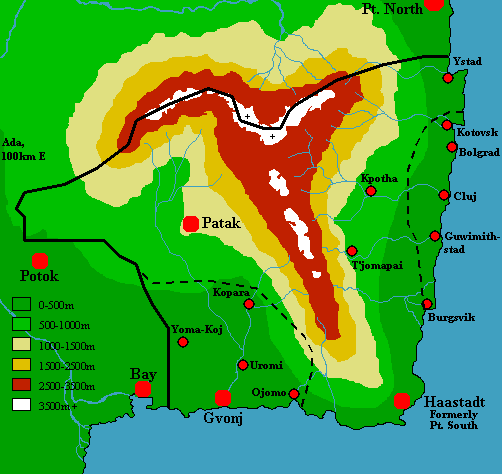 |
Information about Rovens: geography, history and government. |
 |
 |
What is the Peoples Republic of Rovens?
The people of Rovens are seeking their independence from UNV administration. By your positive vote, Rovens will be permitted to establish a provisional government and work our way toward complete independence and autonomy from the control of the UNV. Rovens is the amalgamation of three territories at the north-east of the former Guwimithian Empire Dependencies: Gvonj, Duck Heights (not the whole province) and Port of Olives. Having a racially mixed peoples, we are committed to a multi-ethnic nation guided by people-focused principles. Our three guiding principles will be people, democracy and prosperity. There is much work to be done in reforming the nation, and many people to consider. We are a mostly agrarian economy, with wood, cotton, rubber and tobacco products our major exports to Guwimith in the past. The physical geography of Rovens The country's physical geography is dominated by two key features: the mountain range in the centre of the country that divides it in half, which provides colder climates higher up the mountains, and makes the countryside west of the mountains dryer than the east; and the equator, which means the country is humid and hot, with thick jungle growth. The nation is a total of 643,000 sq.km. A map of the country is below: 
The population of Rovens There is an stated 17.4 million people in Rovens, however, unofficial estimates put the population closer to 23 million. The people are primarily from one of four sources: the indigenous Armatirian-related Pataki people, who are sub-divided into about four sub-groupings; the Gvonj-Utani who arrived in the south-western region of the country up to two thousand years ago, settling and creating a trade-based colony; the Guidarm (pron. G'Darm), an amorphous mix of peoples from various nations around the world, and mixed together to form a homogeneous blend of peoples, who began arriving two hundred and fifty years ago; and the Guwimithians who settled on the east coast and formed the Port of Olives colony 200 years ago. The average lifespan varies from coast to western border, from 70 to 43 respectively. The religion of the people is of no concern to the state, which will neither oppose nor encourage the personal beliefs of the people. The proposed Government of Rovens PIMR is proposing to continue the current interim government until elections can be held for the nation. The proposed constitution will be put to the people in mid-January, if independence is approved by the UNV. It will provide for a General Assembly of up to 600 delegates, representing about 35,000 people each. The General Assembly will elect a Assembly President who will then run the country with the approval of the Assembly. The Assembly will have permission at any time to dismiss the Assembly President. The national flag is a yellow background with ten red stars along the sides, and a green, brown and purple circle pattern, the three colours representing the Gvonj, the Pataki and Guidarm peoples respectively. The Status of Women in the Peoples Republic of Rovens We see the role of women in our society as a positive one, and seek to encourage their active participation in the affairs of government and business. The PIMR-dominated provisional Government of Rovens will seek to have clauses enshrined in the constitution that guarantee the rights of women and all minorities equal to all majority peoples and men. No discrimination will be tolerated for any reason other than criminal record. (On the topic of Criminal record, the PIMR-lead provisional government will strive to put into effect a tough criminal code, but one that emphasises the reform of criminals, firstly by forced detention until the criminal has comprehensively reformed and is guaranteed to never offend again.) The National Economy of Rovens The economy of Rovens is agricultural, with wood, cotton, rubber and tobacco products as primary exports to the former rulers in Guwimith. The people are largely poor, particularly away from the coastal areas, where the Guwimithian, Guidarman and Gvonjian peoples dominate, with the average GDP per capita estimated to be less than C1,000. The Currency is (unofficially) currently the Christiana Crown, but the PIMR intends to establish the Roj (R), tied one-to-one to the Crown with UNVCOCN support. One hundred Oma (ø) will make up a single Roj. The History of Rovens Rovens has a colourful history of three phases, one for each of the major people groups, of triumph, warfare and defeat. The brief history is as follows:
The Military is made up of 40,000 regulars who served in the Dependencies Security forces, plus a navy of 2,000 men and women. The military will play a minor role in the government of the country, restricted to the defence of national borders and shipping routes. The military will be constitutionally disallowed to act against the people, any people group, of Rovens, except where that people group is deemed to be of a seditious nature by the General Assembly. Rovens relationship to Utania? There is quite obviously a significant tie to the nation of Utania by a significant minority of our people, the Gvonj-Utani. It is not, however, our intention to become a colony of the Utani people once again. We declare the past as being the past, and the future as our goal. The people of Gvonj will continue to share a common bond with the Utanian people, but notions of integration with Utania will not be considered. Rovens is one nation, three peoples fused into one skin, and we must forge ahead out common destiny, not hark back to former days. |
 |
|
Copyright © 300 - Peoples Independence Movement for Rovens <Tech> Copyright © 2000 - Mike Ham (except where copyright held by Edward Mooney, Jr., or their respective authors) All Rights Reserved Not to be copied or reproduced in any way without permission. Webmaster: Mike Ham |
||